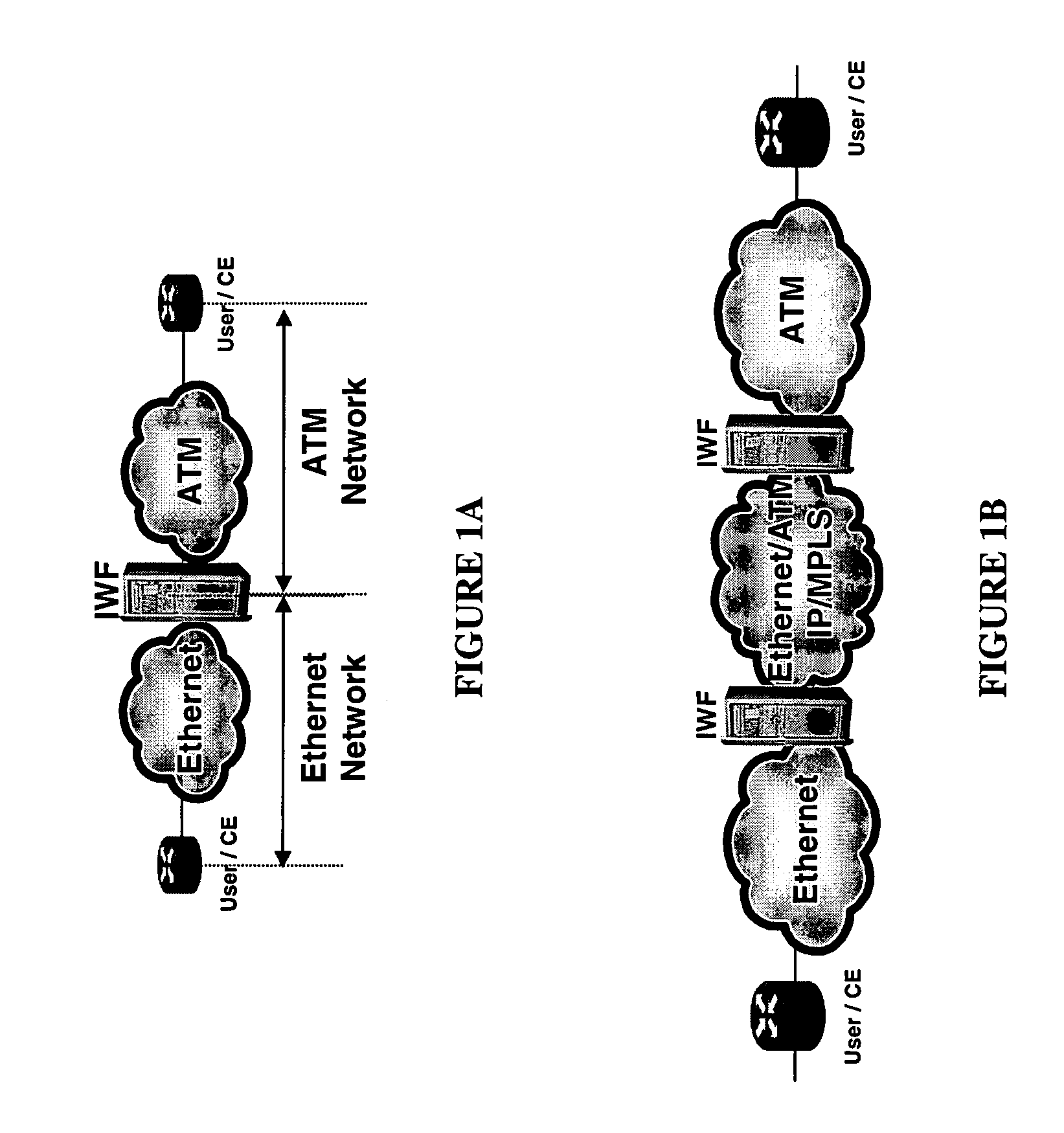Ethernet to ATM interworking with multiple quality of service levels
a technology of quality service and ethernet, applied in the direction of digital transmission, data switching by path configuration, electrical equipment, etc., can solve the problems of not supporting atm standards do not support multiple qos levels per connection, and many types of connectivity
- Summary
- Abstract
- Description
- Claims
- Application Information
AI Technical Summary
Benefits of technology
Problems solved by technology
Method used
Image
Examples
second embodiment
[0068]FIG. 3 illustrates a schematic of an Ethernet / ATM communication system 50 according to the present invention. The communication system 50 includes a first CE 52 connected to first IWU 54 with multiple Ethernet port connections (60, 62, 64, 66). The communication system 50 further includes a second CE 58 connected to a second IWU 56 with multiple virtual circuit connections (70, 72, 74, 76). The IWUs 54, 56 are also connected together over a network link (not shown) through a core network 61.
[0069] In this embodiment of the invention, the data packets transmitted across the network from the first CE 52 to the second CE 58 are each classified with a QoS level as described above. Ethernet data packets are transmitted from the first CE 52 to the first IWU 54 over the multiple Ethernet port connections, with each port connection transmitting data packets designated with a specific QoS level. For example, the Ethernet port 60 may be used to transmit platinum level data packets, the ...
third embodiment
[0075] In particular, FIG. 4 is a schematic of the present invention including a single Ethernet interface and multiple ATM VCCs where multiple QoS levels are provided. In such an embodiment, the ATM side uses one VCC for each QoS level (CBR, CBR, UBR) and the Ethernet side uses one interface (in VLAN-unaware mode) or one VLAN for all QoS levels. The p-bits are used for determining QoS. This configuration results in segregation of each QoS stream on the ATM side for interoperability with legacy ATM equipment, while using a single port or VLAN on the Ethernet side for efficiency and scalability.
fourth embodiment
[0076]FIG. 5 is a schematic of the present invention including a single Ethernet interface (or VLAN) and a single ATM VCC where multiple QoS levels are provided. In such an embodiment, one VCC with Diff-Serv DSCP (or any other L3-L7 protocol, which may also include policy attributes, e.g., subscriber-ID) selects QoS on the ATM side while one Ethernet interface or one VLAN with Diff-Serv DSCP (or any other L3-L7 protocol together with policy attributes) selects QoS on the Ethernet side. This configuration results in operational simplicity, scalability, and dynamic bandwidth sharing and can work with either Ethernet interfaces operating in VLAN-unaware or VLAN-aware mode. However, this configuration is not a pure L2 service, but depends on L3 or higher layer protocol and may not be suitable for non-IP traffic thereby requiring modern IP-Aware Ethernet and ATM switches. The FIG. 5 configuration is similar to that of FIG. 2, except that Upper Layer Protocol (ULP) information (such as IP...
PUM
 Login to View More
Login to View More Abstract
Description
Claims
Application Information
 Login to View More
Login to View More - R&D
- Intellectual Property
- Life Sciences
- Materials
- Tech Scout
- Unparalleled Data Quality
- Higher Quality Content
- 60% Fewer Hallucinations
Browse by: Latest US Patents, China's latest patents, Technical Efficacy Thesaurus, Application Domain, Technology Topic, Popular Technical Reports.
© 2025 PatSnap. All rights reserved.Legal|Privacy policy|Modern Slavery Act Transparency Statement|Sitemap|About US| Contact US: help@patsnap.com



